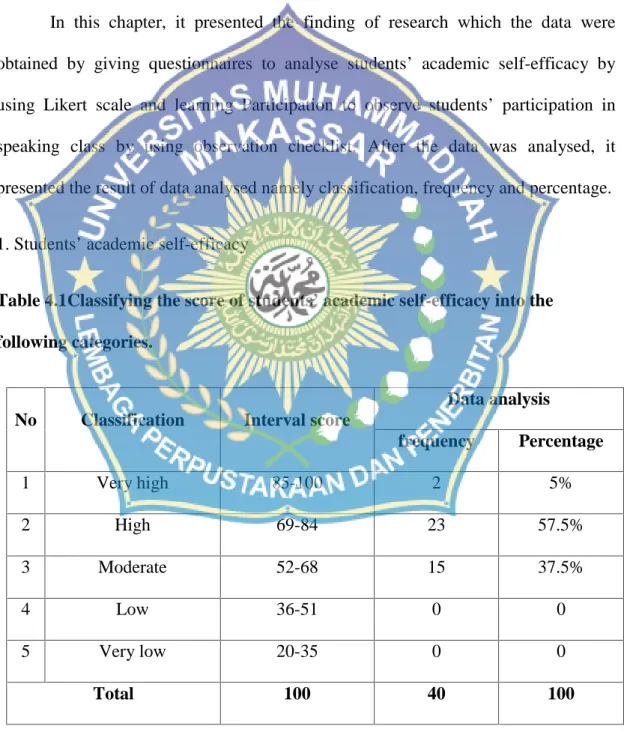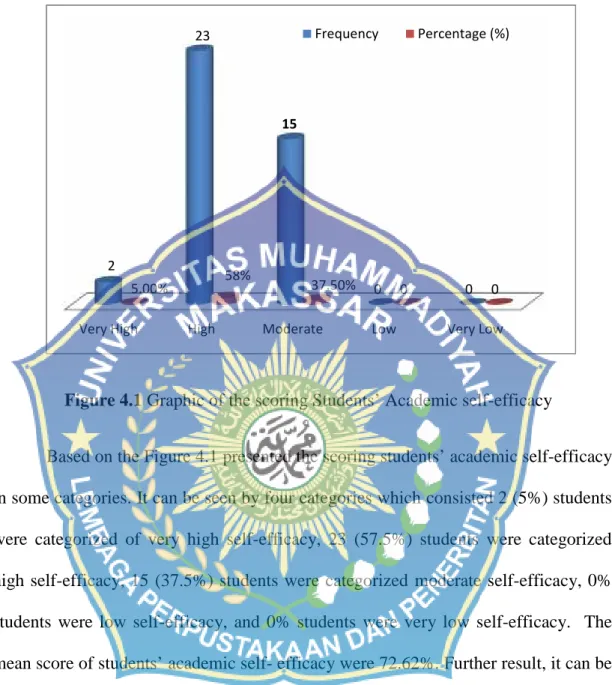INTRODUCTION
Objective of Study
Significance of Study
Scope of Study
THEORIES OF RELATED LITERATURE
Sources of self-efficacy
Also called enactive mastery, enactive achievement, or performance attainment, is the most powerful source of self-efficacy. Emotional states or emotional arousal are another source of efficacy that influences the perception of self-efficacy towards situation. Perceived self-efficacy to control thought processes is a key factor in regulating thoughts that cause stress and depression.
In the term of choice of activities, self-efficacy undertake difficult and challenging tasks more easily than ineffective students do. Furthermore, measures of self-efficacy correlate significantly with students' choice of college major, success in coursework, and persistence. Self-efficacy beliefs are. The direct effect indicates that perceived self-efficacy influences students' method of learning as well as their motivational processes.
Thus, from various influences, we see that self-efficacy plays a role in students' academic motivation in learning. Self-efficacy also affects the standards of self-evaluation that students use to judge the results of their self-control.
The Concept of Learning Participation
- Students as Participation
- Learner style 20
- Elements of Speaking
- Characteristic of Successful in Speaking
- Problems in Speaking
According to Davis Keit in Suryosubroto(2002:279) it states that participation is the involvement of a person's mental and emotional for achieving the goals and taking responsibility. It can be said that the real participation is a symptom of democracy in which people participate in the planning and in the execution and also bear responsibility in accordance with the maturity level and the extent of their obligation. Based on the explanation above, the researcher defines that Learning Participation is the learning that involves students' participation to interact with the circumstances in learning through experience, students' need, groups even community to involve the students who are actively learning in the classroom.
Students as participation in learning is the participation of students in the learning process to achieve the goal that the learning outcomes of students are satisfactory. He looks at the teacher as a point of reference and deals with the goal of the learning group. Bygate (1987:3) says that in order to achieve a communicative goal through speaking, two aspects must be taken into account - knowledge of the language and the ability to use this knowledge.
It is not enough to possess a certain amount of knowledge, but a speaker of the language must be able to use this knowledge in different situations. Speaking ability itself can be expressed as the ability to use language accurately to express meaning to transfer or receive knowledge and information from other people in all life situations. Nunan (1991:40) says that speaking is the use of language in the simplest way by producing ordinary sounds.
If there is no utterance, both speakers and listeners will use the sign. Harmer (1991:21) says that there are some elements of speaking, they are pronunciation, vocabulary, grammar and fluency. In oral communication, there are two ways of processing between speaker and listener and natives the productive speaking skill and the receptive skill understanding.
Everyone gets a chance to speak and contributions are distributed equally. The teacher must control everyone in the class. For example, in class, worried about making mistakes, afraid of the critic or losing face, or simply scared of the attention their speech attracts. Some students are silent, while others speak very little or cannot express their idea optimally in the discussion.
Conceptual Framework
Based on the conceptual framework that found a correlation between students' academic self-efficacy and their learning participation in speech class, it could be seen that students who have high self-efficacy tend to influence their learning success by seeing the sources of self-efficacy. These self-efficacy dimensions that were analyzed were magnitude, strength, and generality by administering questionnaires. On the other hand, to observe students' learning participation, oral activities, content and topic were analyzed using an observation checklist.
Hypotheses
Its purpose was to describe the correlation between students' academic self-efficacy and their learning participation in speaking classes in the third semester of the Department of English Education, Muhammadiyah University, Makassar. Questionnaires were used to know students' academic self-efficacy regarding their speaking in the classroom. The aim was to examine students' academic self-efficacy, which refers to students' self-efficacy when faced with a specific task in a speaking class.
Then the researcher analyzed the data by using the Likert scale to find out the academic self-efficacy of the students. It aimed to observe the students' participation in the learning process in the speaking class, where it showed their self-efficacy while speaking the class. If H0 was rejected, it is believed that there was a high correlation between the student's academic self-efficacy and their learning Participation in the speech class.
This meant that all students agreed that they were really self-efficacious in their speaking lessons, which is stated in point 1. This meant that all students agreed that they were self-efficacious in learning English. This meant that all the students were Agree that they were self-efficacious in learning English.
This meant that students had high self-efficacy in the speaking class, which indicated that 22 (55%) chose 'Agree'. From the table above, it showed the correlation between students' academic self-efficacy and their learning participation in the speaking class. The significance of students' self-efficacy and learning participation to average score students' academic self-efficacy.
Pembahasan bertujuan untuk mendeskripsikan efikasi diri akademik mahasiswa semester III dan partisipasinya dalam pembelajaran. Berdasarkan penelitian ditemukan bahwa korelasi antara efikasi diri akademik siswa dan partisipasi mereka dalam pembelajaran di kelas berbicara adalah korelasi yang rendah. Instrumen penelitian ini berupa angket (pernyataan) yang bertujuan untuk mengetahui efikasi diri akademik siswa pada kelas berbicara.
RESEARCH METHOD
Research Variables
In the Independent variable refers to the student's Academic self-efficacy, and the Dependent variable refers to Learning Participation in speaking class.
Population and Sample
- Population
- Sample
Research Instrument
Procedure of Data collection
The selection of research used cluster random sampling, where three classes (F, H and I) were randomly taken 13 students. The number of students as a sample consisted of 40 students in the third semester of English Education Department at Muhammadiyah University of Makassar Academic Year 2016/2017. Input: The researcher observed the students' oral activities, where the students involved a whole in the speaking class.
Process: the learning process was seen by the students' reaction to the material where the lecturer was involved in the lesson when they were actively speaking in front of the class or individual. The result: students who were actively involved in learning included students in learning participation, while students who were not active.
Technique of Data Analysis
In this chapter, it presented the results of the research that the data was obtained by providing questionnaires to analyze students' academic self-efficacy by using the Likert scale and learning participation to observe students' participation in the speaking class by using observation checklist. It can be seen from four categories, which consisted of 2 (5%) students were categorized by very high self-efficacy students were categorized high self-efficacy students were categorized moderate self-efficacy, 0%. In the collection of data, the researcher found that students have low self-efficacy to learn English, for example speaking lessons.
Based on the statement of Pajares (2002:59) in the British Journal of Education, he said that self-efficacy is a key factor that contributes to students' success because self-efficacy influenced the decisions and course of action they take. It showed that students had low self-efficacy in speaking, which meant that it affected their contribution, which has less participation in speaking class. Nevertheless, self-efficacy was dominant, students who had high self-efficacy studied more actively, because this was reflected in the reduction of their fear, anxiety and feeling of hesitation in completing the task that the students undertake.
This is precisely why self-efficacy is one of the most powerful behavioral motives. Those elements that students had self-efficacy supported by core self-efficacy were mastery experience, vicarious experience, social persuasion, and emotional arousal. When faced with a difficult task, people who have high self-efficacy will approach the challenge as something to be learned and mastered.
Perceived self-efficacy to control thought processes was a key factor in regulating thought-induced stress and depression. By selecting the environment, people can create favorable environments in which they can exercise some control and have a strong sense of self-efficacy. It seemed that when students have high self-efficacy, it motivates them to participate in learning.
Kuesioner ini tidak dimaksudkan untuk menguji atau menelaah Anda, melainkan untuk mendapatkan gambaran yang jelas mengenai efikasi diri akademik siswa pada kelas berbicara. Silakan beri nilai (√) pada beberapa pernyataan di bawah ini: Kuesioner ini berisi beberapa kuesioner yang berhubungan dengan efikasi diri akademik siswa dalam berbicara, dimana.

FINDINGS AND DISCUSSION

